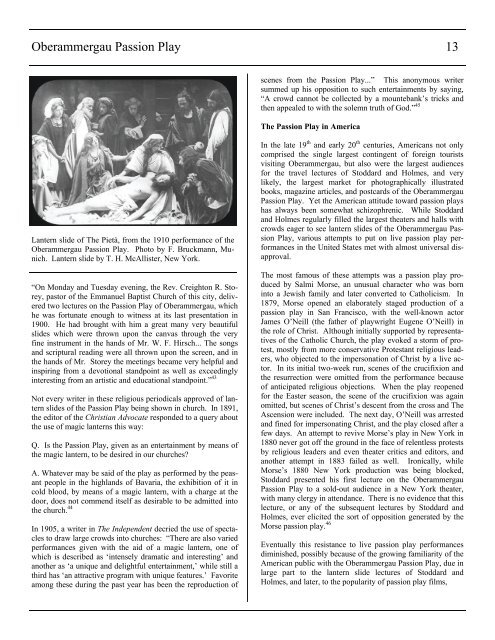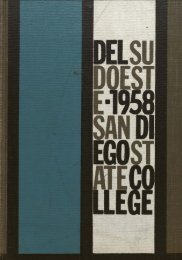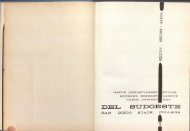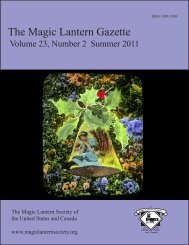The Magic Lantern Gazette - Library
The Magic Lantern Gazette - Library
The Magic Lantern Gazette - Library
You also want an ePaper? Increase the reach of your titles
YUMPU automatically turns print PDFs into web optimized ePapers that Google loves.
Oberammergau Passion Play 13<br />
scenes from the Passion Play...” This anonymous writer<br />
summed up his opposition to such entertainments by saying,<br />
“A crowd cannot be collected by a mountebank’s tricks and<br />
then appealed to with the solemn truth of God.” 45<br />
<strong>The</strong> Passion Play in America<br />
<strong>Lantern</strong> slide of <strong>The</strong> Pietà, from the 1910 performance of the<br />
Oberammergau Passion Play. Photo by F. Bruckmann, Munich.<br />
<strong>Lantern</strong> slide by T. H. McAllister, New York.<br />
“On Monday and Tuesday evening, the Rev. Creighton R. Storey,<br />
pastor of the Emmanuel Baptist Church of this city, delivered<br />
two lectures on the Passion Play of Oberammergau, which<br />
he was fortunate enough to witness at its last presentation in<br />
1900. He had brought with him a great many very beautiful<br />
slides which were thrown upon the canvas through the very<br />
fine instrument in the hands of Mr. W. F. Hirsch... <strong>The</strong> songs<br />
and scriptural reading were all thrown upon the screen, and in<br />
the hands of Mr. Storey the meetings became very helpful and<br />
inspiring from a devotional standpoint as well as exceedingly<br />
interesting from an artistic and educational standpoint.” 43<br />
Not every writer in these religious periodicals approved of lantern<br />
slides of the Passion Play being shown in church. In 1891,<br />
the editor of the Christian Advocate responded to a query about<br />
the use of magic lanterns this way:<br />
Q. Is the Passion Play, given as an entertainment by means of<br />
the magic lantern, to be desired in our churches?<br />
A. Whatever may be said of the play as performed by the peasant<br />
people in the highlands of Bavaria, the exhibition of it in<br />
cold blood, by means of a magic lantern, with a charge at the<br />
door, does not commend itself as desirable to be admitted into<br />
the church. 44<br />
In 1905, a writer in <strong>The</strong> Independent decried the use of spectacles<br />
to draw large crowds into churches: “<strong>The</strong>re are also varied<br />
performances given with the aid of a magic lantern, one of<br />
which is described as ‘intensely dramatic and interesting’ and<br />
another as ‘a unique and delightful entertainment,’ while still a<br />
third has ‘an attractive program with unique features.’ Favorite<br />
among these during the past year has been the reproduction of<br />
In the late 19 th and early 20 th centuries, Americans not only<br />
comprised the single largest contingent of foreign tourists<br />
visiting Oberammergau, but also were the largest audiences<br />
for the travel lectures of Stoddard and Holmes, and very<br />
likely, the largest market for photographically illustrated<br />
books, magazine articles, and postcards of the Oberammergau<br />
Passion Play. Yet the American attitude toward passion plays<br />
has always been somewhat schizophrenic. While Stoddard<br />
and Holmes regularly filled the largest theaters and halls with<br />
crowds eager to see lantern slides of the Oberammergau Passion<br />
Play, various attempts to put on live passion play performances<br />
in the United States met with almost universal disapproval.<br />
<strong>The</strong> most famous of these attempts was a passion play produced<br />
by Salmi Morse, an unusual character who was born<br />
into a Jewish family and later converted to Catholicism. In<br />
1879, Morse opened an elaborately staged production of a<br />
passion play in San Francisco, with the well-known actor<br />
James O’Neill (the father of playwright Eugene O’Neill) in<br />
the role of Christ. Although initially supported by representatives<br />
of the Catholic Church, the play evoked a storm of protest,<br />
mostly from more conservative Protestant religious leaders,<br />
who objected to the impersonation of Christ by a live actor.<br />
In its initial two-week run, scenes of the crucifixion and<br />
the resurrection were omitted from the performance because<br />
of anticipated religious objections. When the play reopened<br />
for the Easter season, the scene of the crucifixion was again<br />
omitted, but scenes of Christ’s descent from the cross and <strong>The</strong><br />
Ascension were included. <strong>The</strong> next day, O’Neill was arrested<br />
and fined for impersonating Christ, and the play closed after a<br />
few days. An attempt to revive Morse’s play in New York in<br />
1880 never got off the ground in the face of relentless protests<br />
by religious leaders and even theater critics and editors, and<br />
another attempt in 1883 failed as well. Ironically, while<br />
Morse’s 1880 New York production was being blocked,<br />
Stoddard presented his first lecture on the Oberammergau<br />
Passion Play to a sold-out audience in a New York theater,<br />
with many clergy in attendance. <strong>The</strong>re is no evidence that this<br />
lecture, or any of the subsequent lectures by Stoddard and<br />
Holmes, ever elicited the sort of opposition generated by the<br />
Morse passion play. 46<br />
Eventually this resistance to live passion play performances<br />
diminished, possibly because of the growing familiarity of the<br />
American public with the Oberammergau Passion Play, due in<br />
large part to the lantern slide lectures of Stoddard and<br />
Holmes, and later, to the popularity of passion play films,
















